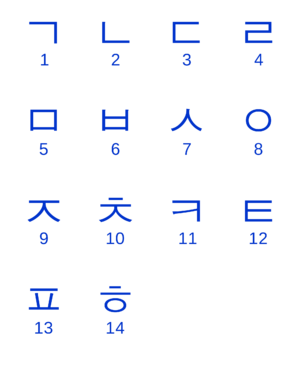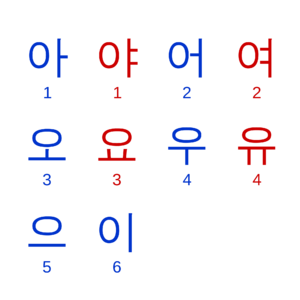اللغة الكورية
| كورية | |
|---|---|
| 한국어, 조선말 Hangugeo, Chosŏnmal | |
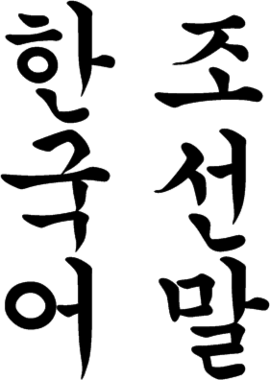 Hangugeo, Chosŏnmal (Korean) written in Hangul, Chosŏn'gŭl | |
| موطنها | كوريا الجنوبية، كوريا الشمالية، الصين، اليابان |
الناطقون الأصليون | 78 مليون (1999)[1] |
Debated (انظر التصنيف) | |
| Exclusive use of Hangul (Both Koreas), mix of Hangul and hanja (some professional scripts in S. Korea), or Cyrillic alphabet (lesser used in Goryeomal) | |
| الوضع الرسمي | |
لغة رسمية في | |
| ينظمها | South Korea: The National Institute of the Korean Language 국립국어원/ 國立國語院 North Korea: Sahoe Kwahagwon Ŏhak Yŏnguso The Language Research Institute of Social Science 사회과학원 어학연구소 |
| أكواد اللغات | |
| ISO 639-2 | kor |
| ISO 639-2 | kor |
| ISO 639-3 | kor |
| Linguasphere | 45-AAA-a |
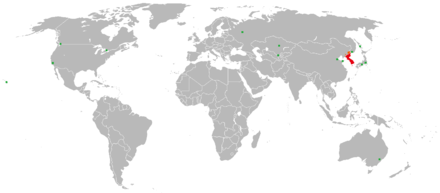 بلدان تتحدث باللغة الكورية كلغة أصلية. | |
اللغة الكورية (بالكورية:한국어 هانْكُكْ ءو)، هي اللغة المستخدمة في شبه الجزيرة الكورية، وهي لغة رسمية في كوريا الشمالية وكوريا الجنوبية. اللغة تُحدث في يانبيان الصينية.
حول العالم هناك 78 مليون متحدث اللغة الكورية، معظمهم في استراليا، الولايات المتحدة، كندا، البرازيل، اليابان والفلبين.
يعد الكوريون لغتهم أحد أهم العناصر المكونة لشعورهم القومي. وهي لغة التصاقية؛ أي إنها تتميز باعتمادها الكبير في بناء المفردات وتبيان العلاقات النحوية على الالتصاق، فتتألف كلماتها من جذر الكلمة ومجموعة من العناصر واضحة المعنى والوظيفة تلتصق بأول الجذر وآخره. وهذا ما دفع بعض اللسانيين إلى القول إنها تعود في جذورها البعيدة إلى العائلة نفسها التي تنتمي إليها لغات شديدة التنوع كالمنغولية والتركية والهنغارية والفنلندية. تشترك الكورية واليابانية في عدد من الخصائص النحوية لكنهما تختلفان اختلافاً كبيراً من حيث المفردات واللواحق التي تلتصق بجذر الكلمة، الأمر الذي يجعل من المستبعد ردّهما إلى أصل واحد.
كانت أصوات اللغة الكورية تكتب بالأحرف الصينية. إلاّ أن نظام الكتابة الصينية لم يكن يتناسب إطلاقاً وهذه اللغة التي تختلف اختلافاً جوهرياً عن اللغة الصينية، الأمر الذي جعل من الصعب على عامة الشعب تعلم الكتابة؛ فسنَّ الملك سي دجونغ Se djong (1418-1450) قانوناً فرض بموجبه نظاماً أبجدياً جديداً كان من شأنه نشر الثقافة بين عامة الشعب، الأمر الذي جُوبِه حينها باستنكار عدد كبير من أبناء الطبقة المثقفة، ويعدّ الملك سي دجونغ اليوم بطلاً قومياً.
تمتاز الأبجدية الكورية التي اخترعها في القرن الخامس عشر فريق من العلماء كان يعمل في بلاط الملك سي دجونغ بالدقة والبساطة، وتسمى «هان- غول»han-geul . تتألف هذه الأبجدية من عشرة صوائت وأربعة عشر صامتاً تعبّر بدقة نادرة عن كل أصوات اللغة الكورية. تكتب الأحرف الصامتة على شكل رموز توضّح توضّع اللسان والشفاه. فعلى سبيل المثال، يكتب رمز ك/غ على شكل لسان يسد الحلق. أمّا الصوائت فهي تعود في أصول كتابتها إلى المبادئ الكونية الثلاثة في الديانة الطاوية Taoïsm، فهي كناية عن مركبات من النقطة «.» رمز السماء، والخط الأفقي «_» رمز الأرض، والخط العمودي «|» رمز الإنسان. غدت الأبجدية الكورية واسعة الانتشار، وإن كانت معرفة الأحرف الصينية أمراً لا غنى عنه لقراءة العديد من النصوص التي ألّفتها مجموعة الكيساينغ، وهن كاتبات البلاط الملكي. فرض اليابانيون حظراً تاماً على استخدام الأبجدية الكورية طوال فترة الاحتلال (1910-1945)، وقد تحوّلت منذ الاستقلال إلى رمز للسيادة الوطنية، حتى إن يوم الاستقلال الذي يصادف الرابع من تشرين الأول/أكتوبر أصبح يوم عيد وطني يحمل اسم «يوم هان-غول».
تتصف الجملة في اللغة الكورية ببنية تصاعدية يتوضّع الفعل دوماً في آخرها. يتحدث الكوريون كلهم اللغة نفسها مع بعض الاختلافات في اللهجات بحسب المناطق. وقد اعتمدت لهجة سيؤول لغة رسمية لكوريا الجنوبية وهي تدين بانتشارها الكبير إلى وسائل الإعلام المرئية والمسموعة. أما في الشمال فلا تزال اللهجات المحلية سائدة بسبب بدائية وسائل الاتصال إلا أن لهجة العاصمة بيونغ يانغ هي الغالبة.
اللهجات
| لهجة قياسية | الاستخدام |
|---|---|
| سول | سول (서울), Incheon (인천/仁川), most of Gyeonggi (경기/京畿) |
| P'yŏngan (평안
/平壤) |
P'yŏngyang, P'yŏngan region, Chagang (كوريا الشمالية) |
| لهة محلية | الاستخدام |
| Gyeonggi | limited areas of the Gyeonggi region (كوريا الجنوبية) |
| Chungcheong | Daejeon, Chungcheong region (كوريا الجنوبية) |
| Gangwon | Gangwon-do (South Korea)/Kangwŏn (كوريا الشمالية) |
| Gyeongsang | Busan, Daegu, Ulsan, Gyeongsang region (South Korea) |
| Hamgyŏng | Rasŏn, Hamgyŏng region, Ryanggang (North Korea) |
| Hwanghae | Hwanghae region (North Korea) |
| Jeju | Jeju Island/Province (South Korea) |
| Jeolla | Gwangju, Jeolla region (South Korea) |
الحروف
가(ga) 나(na) 다(da) 라(ra) 마(ma) 바(ba:
- 사(sa) 아(a) 자(ja) 차(cha) 카(ka) 타(ta) 파(pa) 하(ha)a
아(a) 야(ya) 어(eo) 여(yeo) 오(o) 요(yo) 우(woo) 유(you) 으(eu) 이(i
الأصوات
الحروف الساكنة
| Bilabial | Alveolar | Post- alveolar |
Velar | Glottal | ||
|---|---|---|---|---|---|---|
| Nasal | ㅁ /m/ | ㄴ /n/ | ㅇ /ŋ/ (syllable-final) | |||
| Plosive and Affricate |
plain | ㅂ /b/ or /p/ | ㄷ /d/ or /t/ | ㅈ /t͡ɕ/ | ㄱ /ɡ/ or /k/ | |
| tense | ㅃ /p͈/ | ㄸ /t͈/ | ㅉ /t͡ɕ͈/ | ㄲ /k͈/ | ||
| aspirated | ㅍ /pʰ/ | ㅌ /tʰ/ | ㅊ /t͡ɕʰ/ | ㅋ /kʰ/ | ||
| Fricative | plain | ㅅ /s/ | ㅎ /h/ | |||
| tense | ㅆ /s͈/ | |||||
| Liquid | ㄹ /l/ | |||||
حروف العلة

|

|
| Monophthongs | /i/ ㅣ, /e/ ㅔ, /ɛ/ ㅐ, /a/ ㅏ[1], /o/ ㅗ, /u/ ㅜ, /ʌ/ ㅓ, /ɯ/ ㅡ, /ø/ ㅚ |
|---|---|
| Vowels preceded by intermediaries, or Diphthongs |
/je/ ㅖ, /jɛ/ ㅒ, /ja/ ㅑ, /wi/ ㅟ, /we/ ㅞ, /wɛ/ ㅙ, /wa/ ㅘ, /ɰi/ ㅢ, /jo/ ㅛ, /ju/ ㅠ, /jʌ/ ㅕ, /wʌ/ ㅝ |
^* ㅏ is closer to a Near-open central vowel ([ɐ]), though ‹a› is still used for tradition.
نظام الكتابة
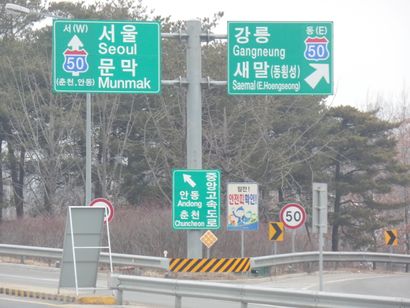
 |
| نظم كتابة اللغة الكورية |
|---|
| هانگول |
|
| هانجا |
| الكتابة الخليط |
| برايل |
| الكتابة |
|
| التحريف |
Before the creation of Hangul, people in Korea (known as Joseon at the time) primarily wrote using Classical Chinese alongside native phonetic writing systems that predate Hangul by hundreds of years, including idu, hyangchal, gugyeol, and gakpil.[2][3][4][5] However, due to the fundamental differences between the Korean and Chinese languages, and the large number of characters needed to be learned, there was much difficulty in learning how to write using Chinese characters for the lower classes, who often didn't have the privilege of education. To assuage this problem, King Sejong (ح. 1418–1450) created the unique alphabet known as Hangul to promote literacy among the common people.[6]
Hangul was denounced and looked down upon by the yangban aristocracy who deemed it too easy to learn,[7][8] but it gained widespread use among the common class,[9] and was widely used to print popular novels which were enjoyed by the common class.[10] With growing Korean nationalism in the 19th century, the Gabo Reformists' push, and the promotion of Hangul in schools,[11] in 1894, Hangul displaced Hanja as Korea's national script.[12] Hanja are still used to a certain extent in South Korea where they are sometimes combined with Hangul, but this method is slowly declining in use despite students learning Hanja in school.[13]
Below is a chart of the Korean alphabet's symbols and their canonical IPA values:
| Hangul | ㅂ | ㄷ | ㅈ | ㄱ | ㅃ | ㄸ | ㅉ | ㄲ | ㅍ | ㅌ | ㅊ | ㅋ | ㅅ | ㅎ | ㅆ | ㅁ | ㄴ | ㅇ | ㄹ | ||
|---|---|---|---|---|---|---|---|---|---|---|---|---|---|---|---|---|---|---|---|---|---|
| RR | b | d | j | g | pp | tt | jj | kk | p | t | ch | k | s | h | ss | m | n | ng | r,l | ||
| IPA | p | t | t͡ɕ | k | p͈ | t͈ | t͡ɕ͈ | k͈ | pʰ | tʰ | t͡ɕʰ | kʰ | s | h | s͈ | m | n | ŋ | w | r | j |
| Hangul | ㅣ | ㅔ | ㅚ | ㅐ | ㅏ | ㅗ | ㅜ | ㅓ | ㅡ | ㅢ | ㅖ | ㅒ | ㅑ | ㅛ | ㅠ | ㅕ | ㅟ | ㅞ | ㅙ | ㅘ | ㅝ |
|---|---|---|---|---|---|---|---|---|---|---|---|---|---|---|---|---|---|---|---|---|---|
| RR | i | e | oe | ae | a | o | u | eo | eu | ui | ye | yae | ya | yo | yu | yeo | wi | we | wae | wa | wo |
| IPA | i | e | ø | ɛ | a | o | u | /ə/ or /ɔ/ | ɯ | ɰi | je | jɛ | ja | jo | ju | /jə/ or /jɔ/ | wi | we | wɛ | wa | /wə/ or /wɔ/ |
The letters of Hangul are not written linearly like most alphabets, but instead arranged into blocks that represent a syllable. So, while the word bibimbap is written as eight characters in a row in English, in Korean it is written 비빔밥, as three syllable blocks in a row. The syllable blocks are then written left to right, top to bottom.
Modern Korean is written with spaces between words, a feature not found in Chinese or Japanese (except when writing exclusive in hiragana, as in children's books). Korean punctuation marks are almost identical to Western ones. Traditionally, Korean was written in columns, from top to bottom, right to left, but is now usually written in rows, from left to right, top to bottom.
| الكلمة | المعنى | النطق | |||
|---|---|---|---|---|---|
| الشمال (RR/MR) | الشمال (Hangul) | الجنوب (RR/MR) | الجنوب (Hangul) | ||
| 읽고 | to read (continuative form) |
ilko (ilko) | 일코 | ilkko (ilkko) | 일꼬 |
| 압록강 | Amnok River | amrokgang (amrokkang) | 암록깡 | amnokkang (amnokkang) | 암녹깡 |
| 독립 | independence | dongrip (tongrip) | 동립 | dongnip (tongnip) | 동닙 |
| 관념 | idea / sense / conception | gwallyeom (kwallyŏm) | 괄렴 | gwannyeom (kwannyŏm) | 관념 |
| 혁신적* | innovative | hyeoksinjjeok (hyŏksintchŏk) | 혁씬쩍 | hyeoksinjeok (hyŏksinjŏk) | 혁씬적 |
* Similar pronunciation is used in the North whenever the hanja "的" is attached to a Sino-Korean word ending in ㄴ, ㅁ or ㅇ. (In the South, this rule only applies when it is attached to any single-character Sino-Korean word.)
التهجي
| الكلمة | المعنى | النطق (RR/MR) | Remarks | |
|---|---|---|---|---|
| النطق في الشمال | النطق في الجنوب | |||
| 해빛 | 햇빛 | sunshine | haeppit (haepit) | The "sai siot" ('ㅅ' used for indicating sound change) is almost never written out in the North. |
| 벗꽃 | 벚꽃 | cherry blossom | beotkkot (pŏtkkot) | |
| 못읽다 | 못 읽다 | cannot read | monnikda (monnikta) | Spacing. |
| 한나산 | 한라산 | Hallasan | hallasan (hallasan) | When a ㄴ-ㄴ combination is pronounced as ll, the original Hangul spelling is kept in the North, while the Hangul is changed in the South. |
| 규률 | 규율 | rules | gyuyul (kyuyul) | In words where the original hanja is spelt "렬" or "률" and follows a vowel, the initial ㄹ is not pronounced in the North, making the pronunciation identical with that in the South where the ㄹ is dropped in the spelling. |
التهجي والنطق
| الكلمة | المعنى | Remarks | |||
|---|---|---|---|---|---|
| النطق في الشمال | North pronun. | النطق في الجنوب | South pronun. | ||
| 력량 | ryeongryang (ryŏngryang) | 역량 | yeongnyang (yŏngnyang) | strength | Initial r's are dropped if followed by i or y in the South Korean version of Korean. |
| 로동 | rodong (rodong) | 노동 | nodong (nodong) | work | Initial r's are demoted to an n if not followed by i or y in the South Korean version of Korean. |
| 원쑤 | wonssu (wŏnssu) | 원수 | wonsu (wŏnsu) | mortal enemy | "Mortal enemy" and "head of state" are homophones in the South. Possibly to avoid referring to Kim Il-sung / Kim Jong-il as the enemy, the second syllable of "enemy" is written and pronounced 쑤 in the North. |
| 라지오 | rajio (rajio) | 라디오 | radio (radio) | radio | |
| 우 | u (u) | 위 | wi (wi) | on; above | |
| 안해 | anhae (anhae) | 아내 | anae (anae) | wife | |
| 꾸바 | kkuba (kkuba) | 쿠바 | kuba (k'uba) | Cuba | When transcribing foreign words from languages that do not have contrasts between aspirated and unaspirated stops, North Koreans generally use tensed stops for the unaspirated ones while South Koreans use aspirated stops in both cases. |
| 페 | pe (p'e) | 폐 | pye (p'ye), pe (p'e) | lungs | In the case where ye comes after a constant, such as in hye and pye, it is pronounced without the palatal approximate. North Korean orthography reflect this pronunciation nuance. |
| الاسم الأصلي | الترجمة في كوريا الشمالية | الاسم الإنگليزي | الترجمة في كوريا الجنوبية | ||
|---|---|---|---|---|---|
| التهجي | النطق | التهجي | النطق | ||
| Ulaanbaatar | 울란바따르 | ullanbattareu (ullanbattarŭ) | Ulan Bator | 울란바토르 | ullanbatoreu (ullanbat'orŭ) |
| København | 쾨뻰하븐 | koeppenhabeun (k'oeppenhabŭn) | Copenhagen | 코펜하겐 | kopenhagen (k'op'enhagen) |
| al-Qāhirah | 까히라 | kkahira (kkahira) | Cairo | 카이로 | kairo (k'airo) |
النحو
| الكلمة | المعنى | Remarks | |||
|---|---|---|---|---|---|
| التهجي في الشمال | النطق في الشمال | التهجي في الجنوب | النطق في الجنوب | ||
| 되였다 | doeyeotda (toeyŏtta) | 되었다 | doeeotda (toeŏtta) | past tense of 되다 (doeda/toeda), "to become" | All similar grammar forms of verbs or adjectives that end in ㅣ in the stem (i.e. ㅣ, ㅐ, ㅔ, ㅚ, ㅟ and ㅢ) in the North use 여 instead of the South's 어. |
| 고마와요 | gomawayo (komawayo) | 고마워요 | gomawoyo (komawŏyo) | thanks | ㅂ-irregular verbs in the North use 와 (wa) for all those with a positive ending vowel; this only happens in the South if the verb stem has only one syllable. |
| 할가요 | halgayo (halkayo) | 할까요 | halkkayo (halkkayo) | Shall we do? | Although the Hangul differ, the pronunciations are the same (i.e. with the tensed ㄲ sound). |
المعجم
| الكلمة | المعنى | Remarks | |||
|---|---|---|---|---|---|
| التهجي في الشمال | النطق في الشمال | التهجي في الجنوب | النطق في الجنوب | ||
| 문화주택 | munhwajutaek (munhwajut'aek) | 아파트 | apateu (ap'at'ŭ) | Apartment | 아빠트 (appateu/appat'ŭ) is also used in the North. |
| 조선말 | joseonmal (chosŏnmal) | 한국어 | han-gugeo (han'gugeo) | Korean language | |
| 곽밥 | gwakbap (kwakpap) | 도시락 | dosirak (tosirak) | lunch box | |
| 동무 | dongmu (dongmoo) | 친구 | chingu (chingoo) | Friend | 동무 literally means "comrade" as distinct from "friend," and thus the northern use of 동무 reflects political/ideological tendencies. |
انظر أيضاً
- هانگول
- Korean romanization
- Korean numerals
- Korean phonology
- Korean count word
- Korean language and computers
- Hanja
- Sino-Korean vocabulary
- Korean mixed script
- List of English words of Korean origin
- Altaic languages
- List of Korea-related topics
- Vowel harmony
الهامش
- ^ "Korean". Ethnologue, 14th ed. Retrieved 2008-09-25.
- ^ Hannas, Wm C. Asia's Orthographic Dilemma (in الإنجليزية). University of Hawaii Press. p. 57. ISBN 978-0-8248-1892-0. Retrieved 20 September 2016.
- ^ Chen, Jiangping. Multilingual Access and Services for Digital Collections (in الإنجليزية). ABC-CLIO. p. 66. ISBN 978-1-4408-3955-9. Retrieved 20 September 2016.
- ^ "Invest Korea Journal" (in الإنجليزية). 23. Korea Trade-Investment Promotion Agency. 1 January 2005. Retrieved 20 September 2016.
They later devised three different systems for writing Korean with Chinese characters: Hyangchal, Gukyeol and Idu. These systems were similar to those developed later in Japan and were probably used as models by the Japanese.
{{cite journal}}: Cite journal requires|journal=(help) - ^ "Korea Now" (in الإنجليزية). 29. Korea Herald. 1 July 2000. Retrieved 20 September 2016.
{{cite journal}}: Cite journal requires|journal=(help) - ^ Koerner, E. F. K.; Asher, R. E. Concise History of the Language Sciences: From the Sumerians to the Cognitivists (in الإنجليزية). Elsevier. p. 54. ISBN 978-1-4832-9754-5. Retrieved 13 October 2016.
- ^ Montgomery, Charles (19 January 2016). "Korean Literature in Translation – CHAPTER FOUR: IT ALL CHANGES! THE CREATION OF HANGUL". www.ktlit.com. KTLit. Retrieved 2016-04-20.
Hangul was sometimes known as the "language of the inner rooms," (a dismissive term used partly by yangban in an effort to marginalize the alphabet), or the domain of women.
- ^ Chan, Tak-hung Leo. One Into Many: Translation and the Dissemination of Classical Chinese Literature (in الإنجليزية). Rodopi. p. 183. ISBN 9042008156. Retrieved 26 December 2016.
- ^ "Korea News Review" (in الإنجليزية). Korea Herald, Incorporated. 1 January 1994. Retrieved 26 December 2016.
{{cite journal}}: Cite journal requires|journal=(help) - ^ Lee, Kenneth B. Korea and East Asia: The Story of a Phoenix (in الإنجليزية). Greenwood Publishing Group. p. 90. ISBN 978-0-275-95823-7. Retrieved 26 December 2016.
- ^ Silva, David J. (2008). "Missionary Contributions toward the Revaluation of Han'geul in Late 19th Century Korea" (PDF). International Journal of the Sociology of Language. 192: 57–74. doi:10.1515/ijsl.2008.035.
- ^ "Korean History". Korea.assembly.go.kr. Retrieved 2016-04-26.
Korean Empire, Edict No. 1 – All official documents are to be written in Hangul, and not Chinese characters.
- ^ "현판 글씨들이 한글이 아니라 한자인 이유는?". royalpalace.go.kr (in Korean). Archived from the original on 2017-03-10. Retrieved 2016-04-26.
{{cite web}}: Unknown parameter|dead-url=ignored (|url-status=suggested) (help)CS1 maint: unrecognized language (link)
للاستزادة
- Chang, Suk-jin (1996). Korean. Philadelphia: John Benjamins Publishing Company. ISBN 1556197284. (Volume 4 of the London Oriental and African Language Library).
- Hulbert, Homer B. (1905): A Comparative Grammar of the Korean Language and the Dravidian Dialects in India. Seoul.
- Lee, Ki-Moon Lee and S. Robert Ramsey. A History of the Korean Language (Cambridge University Press; 2011) 352 pages.
- Martin, Samuel E. (1966): Lexical Evidence Relating Japanese to Korean. Language 42/2: 185–251.
- Martin, Samuel E. (1990): Morphological clues to the relationship of Japanese and Korean. In: Philip Baldi (ed.): Linguistic Change and Reconstruction Methodology. Trends in Linguistics: Studies and Monographs 45: 483-509.
- Miller, Roy Andrew (1971): Japanese and the Other Altaic Languages. Chicago: University of Chicago Press. ISBN 0-226-52719-0.
- Miller, Roy Andrew (1996): Languages and History: Japanese, Korean and Altaic. Oslo: Institute for Comparative Research in Human Culture. ISBN 974-8299-69-4.
- Ramstedt, G. J. (1928): Remarks on the Korean language. Mémoires de la Société Finno-Oigrienne 58.
- Rybatzki, Volker (2003): Middle Mongol. In: Juha Janhunen (ed.) (2003): The Mongolic languages. London: Routledge. ISBN 0-7007-1133-3: 47–82.
- Starostin, Sergei A.; Anna V. Dybo; Oleg A. Mudrak (2003): Etymological Dictionary of the Altaic Languages, 3 volumes. Leiden: Brill Academic Publishers. ISBN 90-04-13153-1.
- Sohn, H.-M. (1999): The Korean Language. Cambridge: Cambridge University Press.
- Sohn, Ho-Min (2006). Korean Language in Culture and Society. Boston: Twayne Publishers. ISBN 9780824826949.
- Song, J.-J. (2005): The Korean Language: Structure, Use and Context. London: Routledge.
- Trask, R. L. (1996): Historical linguistics. Hodder Arnold.
- Vovin, Alexander: Koreo-Japonica. University of Hawai'i Press.
- Whitman, John B. (1985): The Phonological Basis for the Comparison of Japanese and Korean. Unpublished Harvard University Ph.D. dissertation.
وصلات خارجية
- CS1 errors: unsupported parameter
- Articles containing كورية-language text
- Language articles with speaker number undated
- Articles containing إنگليزية-language text
- Languages with ISO 639-2 code
- Languages with ISO 639-1 code
- Language articles without reference field
- Language articles missing Glottolog code
- Articles with hatnote templates targeting a nonexistent page
- Pages with plain IPA
- نظام كتابة الكورية
- اللغة الكورية
- لغات إلصاقية
- Languages attested from the 4th century
- لغات معزولة
- لغات كوريا الجنوبية
- لغات كوريا الشمالية
- Buyeo languages
- لغات الصين
- لغات كوريا
- National symbols of Korea
- Subject–object–verb languages
- Syllable-timed languages

